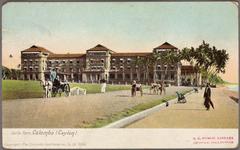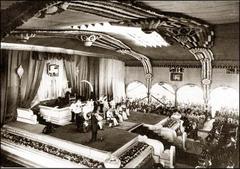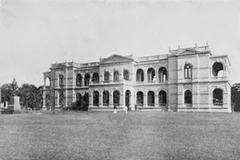Old Parliament Building Colombo: Visiting Hours, Tickets, and Historical Significance
Date: 04/07/2025
Introduction
The Old Parliament Building in Colombo is a monumental symbol of Sri Lanka’s journey from colonial rule to independent nationhood. Located at the edge of Galle Face Green and overlooking the Indian Ocean, this neoclassical masterpiece has served as the backdrop for some of the most important political milestones in Sri Lankan history. This comprehensive guide explores the building’s history, architectural highlights, practical visitor information—including visiting hours and ticket procedures—and offers travel tips to help you make the most of your visit (Daily News, Parliament of Sri Lanka, Holiday Tour Plan).
Table of Contents
- Historical Context and Colonial Origins
- Architectural Highlights
- Political and Cultural Significance
- Heritage Status and Preservation
- Visitor Information
- Nearby Attractions
- Frequently Asked Questions (FAQ)
- Visual Media
- Related Articles
- Summary and Recommendations
- References
Historical Context and Colonial Origins
The Old Parliament Building was constructed between 1920 and 1930, designed by Austin Woodeson to reflect the authority and dignity of the British Empire. Its grand neoclassical style, featuring six towering Corinthian columns, was inspired by British and European parliamentary architecture (The Sunday Times). The building was inaugurated on January 29, 1930, by Governor Sir Herbert Stanley and initially housed the Legislative Council of Ceylon. With the Donoughmore Constitution of 1931, it became the seat of the State Council and later the Parliament of independent Ceylon, playing a central role in the country’s political evolution.
Architectural Highlights
Neo-Baroque and Neoclassical Grandeur
- Exterior: The building’s symmetrical façade, adorned with massive Corinthian columns and a triangular pediment, faces the ocean—a deliberate gesture signifying openness and connection to the wider world (Holiday Tour Plan).
- Interior: While interior access is restricted, the halls are renowned for their teak paneling, marble floors, and ornate plasterwork, reflecting both imported colonial tastes and local craftsmanship.
- Statues and Gardens: The grounds feature statues of key political figures, including D. S. Senanayake, Sri Lanka’s first Prime Minister, and other leaders who shaped the nation’s destiny (Green Holiday Travels).
Political and Cultural Significance
The building has witnessed landmark events such as the introduction of universal adult franchise, the declaration of independence in 1948, and the passage of important legislation like the Ceylon Citizenship Act. Even after Parliament moved to Sri Jayawardenepura Kotte in 1983, the Old Parliament Building became the Presidential Secretariat and continues to host major state functions, reaffirming its status as a symbol of governance and continuity (Presidential Secretariat, The Island).
Heritage Status and Preservation
Recognized as a protected monument by the Department of Archaeology, the Old Parliament Building is the focus of ongoing conservation efforts that maintain its architectural integrity and historical significance. Restoration projects ensure its preservation for future generations, and its inclusion in heritage walks and educational programs helps foster public appreciation (Department of Archaeology).
Visitor Information
Location and Getting There
- Address: Lotus Road, Colombo Fort, Colombo.
- Access: Easily reached from central Colombo by foot, taxi, tuk-tuk, or public bus. Bus routes 100, 101, and 103 stop nearby (Evendo).
Visiting Hours and Tickets
- Exterior Viewing: The grounds and exterior can be viewed at any time, as the building fronts a public area (Pocket Wanderings).
- Interior Access: The building is not open for regular public tours. Special guided tours or heritage walks may be available during national celebrations or by prior appointment through heritage organizations. Viewing the exterior is free; special tours may require prior booking and a nominal fee.
Accessibility
- The grounds are generally accessible to visitors with mobility challenges, though some areas may have uneven surfaces. Interior access is limited and may require advance arrangement for special tours.
Guided Tours
- Guided heritage walks—offered by local operators—often include the Old Parliament Building alongside other historical sites such as the Colombo National Museum and Galle Face Green. Check with Colombo city tour services for availability.
Security and Photography
- Security: Due to its governmental function, expect a visible security presence. Follow all posted instructions.
- Photography: Photography of the building is generally discouraged and may be restricted; be discreet and respectful (Pocket Wanderings).
Practical Travel Tips
- Best Times: Visit early morning or late afternoon for cooler weather and optimal lighting.
- Dress Code: Modest attire is recommended out of respect for the building’s official status.
- Amenities: There are no public restrooms or visitor facilities on site; use nearby hotels or restaurants.
- Personal Safety: Keep personal belongings secure, especially during busy periods.
Nearby Attractions
- Galle Face Green: A popular urban park for relaxation and sunsets (Pocket Wanderings).
- Colombo National Museum: Sri Lanka’s largest museum, offering insights into national history (Pocket Wanderings).
- Gangaramaya Temple: A unique Buddhist complex blending various architectural influences.
- Colombo Fort: A historic area with colonial-era buildings and vibrant markets.
Frequently Asked Questions (FAQ)
Q: What are the visiting hours for the Old Parliament Building Colombo?
A: The exterior and grounds can be visited at any time. The interior is not open for public tours except by special arrangement.
Q: Are tickets required?
A: No tickets are needed for exterior viewing. Guided tours, if available, may require a nominal fee and advance booking.
Q: Is the building wheelchair accessible?
A: The surrounding area is mostly accessible, but there are no dedicated facilities for visitors with disabilities.
Q: Can I take photographs?
A: Photography is generally discouraged and may be restricted by security personnel.
Q: What other attractions are nearby?
A: Galle Face Green, Colombo National Museum, Gangaramaya Temple, and Colombo Fort.
Visual Media
Related Articles
- Top Historical Sites to Visit in Colombo
- Guide to Galle Face Green and Surroundings
- Exploring Colombo’s Museums and Temples
Summary and Recommendations
The Old Parliament Building in Colombo is an enduring emblem of Sri Lanka’s political and architectural legacy. While interior access is restricted, its exterior grandeur, historical context, and surrounding statues make it a must-see for history enthusiasts and travelers. Combine your visit with nearby attractions like Galle Face Green and the National Museum for a deeper understanding of Colombo’s heritage. For current updates on tours or special events, download the Audiala app and follow official heritage channels (Holiday Tour Plan, Parliament of Sri Lanka, Presidential Secretariat, Daily News).
References
- Old Parliament Building Colombo, 2020, Daily News
- Old Parliament Building and Its Historic Role, 2021, The Island
- Parliamentary History of Sri Lanka, 2023, Parliament of Sri Lanka
- Presidential Secretariat Overview, 2023, Presidential Secretariat of Sri Lanka
- Heritage Conservation in Sri Lanka, 2023, Department of Archaeology
- Old Parliament Building Neoclassical Architecture, 2023, Holiday Tour Plan
- Old Parliament Building Visitor Information, 2024, Pocket Wanderings
- Colombo Old Parliament Building Attraction, 2024, Evendo
- Sri Lanka Constitution and Political Milestones, 2022, ConstitutionNet





